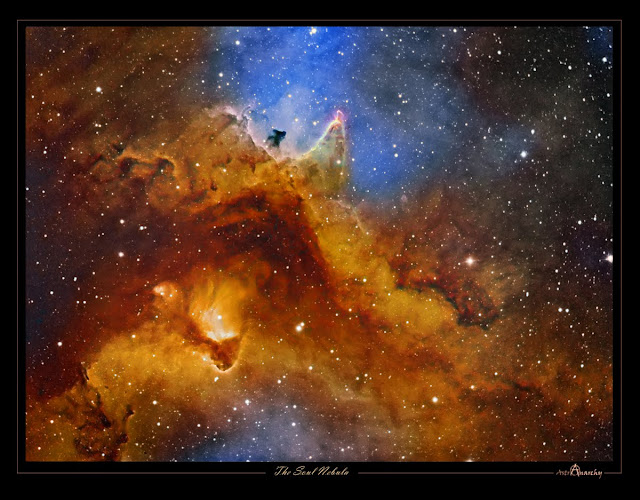COPYRIGHT, PLEASE NOTE
All the material on this website is copyrighted to J-P Metsavainio, if not otherwise stated. Any content on this website may not be reproduced without the author’s permission.
Have a visit in my portfolio
PORTFOLIO:https://astroanarchy.zenfolio.com/
Tuesday, November 24, 2009
Soul Nebula Detail as a Sterogram
Parallel Vision
Cross Vision
-
NOTE! This is a personal vision about forms and shapes, based on some known facts and artistic impression. Wieving instructions can be found from a Right hand side menu.
-
Original Image with details can be found HERE.
-
NEW
Here you can find an Anaglyph, Red/Cyan, Stereo image.
You'll need Red/Cyan Eyeglasses to be able to see images right. Note, if you have a Red and Green filters, you can use them! Red goes to Left eye.
Labels:
anaglyph images and movies,
stereo images
Monday, November 23, 2009
Soul Nebula, testing
Animation, Stars vs No Stars.
-
Sometimes it's usefull to see the Nebula without stars.
Human brains has a tendency to form Shapes and lines from a cloud of dots, in this case Stars.
By removing Stars the actual Nebulosity is seen better.
If the object is located in a very dense Starfield, some dimmer parts might not be seen at all.
I have noticed, that large shapes and formations in a Nebula comes visible by this way.
I can compare this to a CT Scan image, where different tissues can be seen. It's still a real image of the human been, even skin and clothes can't be seen.
After all, in a reality, Stars are only mathematical points, with no dimensions, doe the huge distance.
The difraction and atmosphere blow up the image of a Star to a small disk.
The method used for a Star supression is descripted in a "Tone Mapping" PDF-document HERE. An other sample. Working with a dim targets and an extreme dense Star field: http://astroanarchy.blogspot.com/2009/11/power-of-tone-mapping.html
Labels:
animations,
research and development
Sunday, November 22, 2009
Soul Nebula closeup finalized

 After a long, frustrating period, we finally had kind of clear skys!
After a long, frustrating period, we finally had kind of clear skys!
Actually, I started my imaging session Three times last night and back everything up at between.
Weather was so volatile, since misty clouds from open see are impossible to predict.
-
After all I was able to capture more H-alpha and enough O-III and S-II to build a decent three band narrowband image.
Two versions , as usually, first one in HST-palette and the Second one in "natural colors" mixed from same material as HST-image.
-
Two color chemes,
HST Palette as S-II=Red, H-a=Green and O-III=Blue.
Second image is in natural colors composed from narrowband data. Channels are balanced so, that image match to visible spectrum, H-a + 24%S-II=Red, O-III=Green and O-III + 15%H-alpha=Blue.
-
Processing work flow:
Image acquisition, MaxiDL v5.07.
Stacked and calibrated in CCDStack.
Deconvolution with a CCDSharp, 30 iterations.
Levels, curves and color combine in PS CS3.
-
Telescope, Meade LX200 GPS 12" @ f4.65
Camera, QHY9
Guiding, SXV-AO @ 11Hz
Image Scale, 0,8 arcseconds/pixel
Exposures:
H-alpha 16x1200s Binned 1x1
O-III 3x600s, binned 3x3
S-II 9x600s, binned 3x3
Top of that, some color data from an older wide field image is used.
Wider view to the Soul Nebula. Area of the current image is marked with a frame. -
A Starless version of the Nebula.
I place it here, since it looks kind of nice and the actual Nebulosity can be seen better this way.
Friday, November 20, 2009
Colors in Astro Images
I made two animations to show difference between different Color schemes used in my images.
At an image of the Elephant's Trunk Nebula abowe, differen color variants are animated together.
-
First is pure Hydrogen alpha channel, second is a RGB-broadband image, next is H-aRGB mix. After that, there is pure Narrowband compositions from three channels, H-a, S-II and O-III. First of them is a "Natural Color" composition mixed so, that resulting colors are close to visible spectrum to human eye. Last image is a "Mapped Color" composition, where all three channels are mapped to selected color. In this case the mixture is S-II=Red, H-a=Green and O-III=Blue, this combination is generally known as a Hubble-palette (HST), after a Palette used in images by Space Telescope Hubble.
-
What is the truth then?
Deep space targets are generally so dim, that human eye is not cabable to see any colors from them.
Closest to real colors is the RGB image, if colors are balanced correctly.
Usually a pure white Star is used to measure a correct color balance between Red, Green and Blue data.
Next closest is the H-aRGB mix, where H-alpha filtered image is used to boost contrast and details in image.
It tend to distor the Red balance in image though.
Third, in reality order, is a Narrowband mixture, where different channels are mapped to visible colors as closely as possible by the wavelenghts.
I'm using a mixture by Richard Crisp.
H-a is mapped to Red with about 20% S-II, O-III is Green and the Blue is mixed from O-III and about 15% H-alpha to compensate missing H-beta.
-
The Hubble palette is least realistic color scheme. It's made famous by wonderful pictures from the Hubble Telescope. This palette is developed to maximize visual difference between different ionized Elements in Nebula. Even though it's used in sientific purposes, it's beautiful as well. I use HST-palette for esthetic reasons only, with that tool I'm able to reveal some of the hidden beauty.
An other good reason to use it is, that it's a de facto standard and makes possible to compare images from different narrowband imagers.
-
An other animated example of color palettes, the Pelican Nebula.
Labels:
animations,
research and development
Subscribe to:
Posts (Atom)













